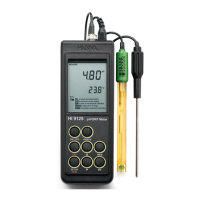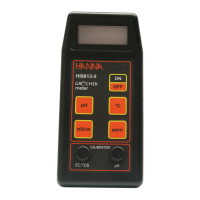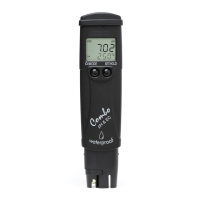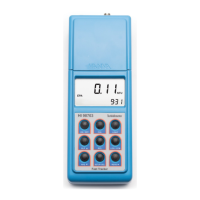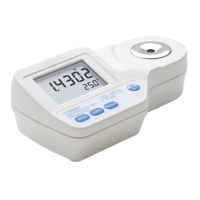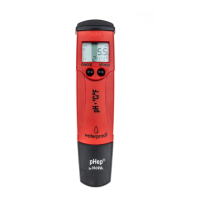15
ORP MEASUREMENTS (HI 9023C AND HI 9025C)
To enter the "mV" mode (ORP or ISE), turn the instrument ON and
press the RANGE key until the display changes to mV.
To measure the mV of a solution simply sub-
merge the ORP or ISE electrode tip (4cm/
1½") into the sample to be tested. Allow a
few minutes for the readings to stabilize. See
also "Taking REDOX Measurements" section at
page 29.
TEMPERATURE MEASUREMENTS (HI 9023C,
HI 9023CN, HI 9024C, HI 9025C AND HI 9210N):
Taking a temperature measurement is very easy. Turn the instrument
ON and press the RANGE key to enter temperature mode.
For HI 9023C, HI 9024C and HI 9025C, dip the liquid/general
purpose temperature probe HI 7669/2W into the sample. For
HI 9023CN and HI 9210N, simply dip the pH/°C electrode which
contains the temperature sensor. Then allow a couple of minutes for
the reading to stabilize.
Note: You can also calibrate the offset point of the HI 9210N tem-
perature sensor, if needed. For this purpose, immerse the pH/
°C electrode in a solution at a known temperature. Then turn
the #5 trimmer (see page 10) until the temperature dis-
played on the LCD is that of the solution.
ON/OFF
ON/OFF
4 cm
(1½")
RANGE
RANGE
26
ELECTRODE CONDITIONING &ELECTRODE CONDITIONING &
ELECTRODE CONDITIONING &ELECTRODE CONDITIONING &
ELECTRODE CONDITIONING &
MAINTENANCEMAINTENANCE
MAINTENANCEMAINTENANCE
MAINTENANCE
PREPARATION
Remove the protective cap.
DO NOT BE ALARMED IF ANY SALT DEPOSITS ARE PRESENT. This is
normal with electrodes and they will disappear when rinsed with water.
During transport tiny bubbles of air may form inside the glass bulb
affecting proper functioning of the electrode. These bubbles can be
removed by "shaking down" the electrode as you would do with a
glass thermometer.
If the bulb and/or junction is dry, soak the electrode in HI 70300 or
HI 80300
Storage Solution for at least one hour.
* Not present in gel electrodes.
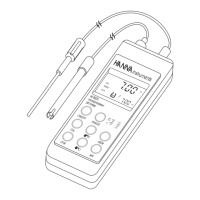
